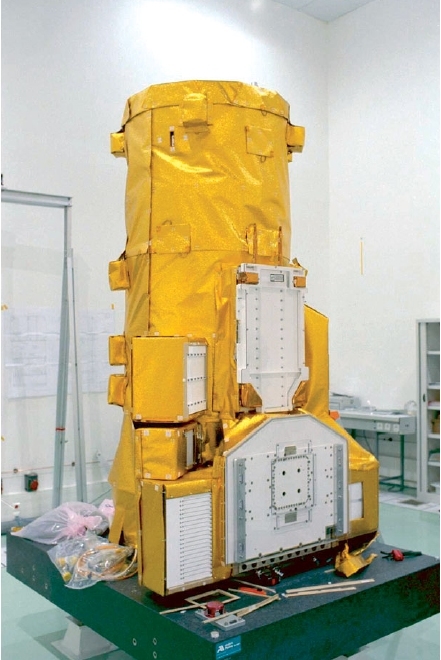SPI Instrument
Of the four instruments forming the Integral observatory, the SPI spectrometer was developped in-house at the Toulouse Space Centre with contributions from several French and foreign laboratories. The original feature of this instrument lies in the high spectral resolution for gamma-rays of about 2 keV over a wide energy range from 20 keV and 8 MeV.

The spectrometer scans the skies (breaks of ten days at a time are possible), observing sources within its field of view. The emissions from these sources are intercepted by the mask at the top of the spectrometer. The mask codes the gamma-ray beams through an arrangement of hexagonal tungsten blocks 3 cm deep and 6 cm across. 63 of the hexagonal blocks are opaque, thus stopping the radiation, and 64 are transparent, letting the gamma rays pass the mask towards the detector.
The coded beam then reaches the detection surface (which covers 500 cm²), at the very heart of the instrument. The chequered design of the mask is such that, once the projected image is processed by suitable correlation functions, the direction of the sources located within the instrument's field of view may be univocally mapped. The detection surface is made up of 19 hexagonal detectors of germanium crystals chilled to 85K by two pairs of compressors. In order to reduce heat losses from the cryostat, its outside temperature is maintained at 200K by two heat pipes. The gamma photon interacts with the germanium semi-conductor, generating a current in proportion to the photon's energy.
This signal is then amplified and converted into a digital signal by the Analogue Front End Electronics unit (AFEE). In parallel, the fast Pulse Shape Discriminator electronic unit (PSD), digitizes the shape of the current pulse for deeper analysis. In fact, most of the event triggers registered by SPI will be generated by locally produced background radiation, which originates from the interaction of high-energetic cosmic-ray particles with the instrument's materials. Using the information contained in the shape of the current pulses, the PSD system is capable of rejecting a large fraction of these background events, thus increasing the signal-to-noise ratio for astrophysical sources.
The radiation captured by the spectrometer does not only come from sources situated within the instrument's field of view, but also from direction outside the field. In order to guard against this interfering signal, the detection surface is surrounded by an "anticoincidence" protective system. At gamma ray energies, it is difficult to stop particles or photons, so this system is based on detecting them as they pass through. A group of scintillating crystals generates a time-tagged current whenever an interfering particle passes through. This signal is then sent along with the signals from the germanium detectors to the Digital Front End Electronics unit (DFEE) which determines in real time whether the two types of signal coincide or not. If they do, the particle detected by the germanium crystals does not fall within the instrument's field of view and is eliminated.
Once this selection process is over, the DFEE sends its data to the onboard computer which then processes it: drawing up spectra, and formatting data packets to be sent to the ground via the satellite's telemetry link.
| Facts and figures about the spectrometer | |
| Mass | 1230 kg |
| Height | 2.8 m |
| Diameter | 1.1 m |
| Power | 310 W |
| Telemetry | 22 kb/s |
| Field of View | 16° |
| Energy range | 20 keV - 8 MeV |
| Resolution | 3 keV at 1.33 MeV |
| Sensitivity | 3 10E-06 photon / cm2.s at 1 MeV 2 10E-05 photon / cm2.s at 511 keV |

